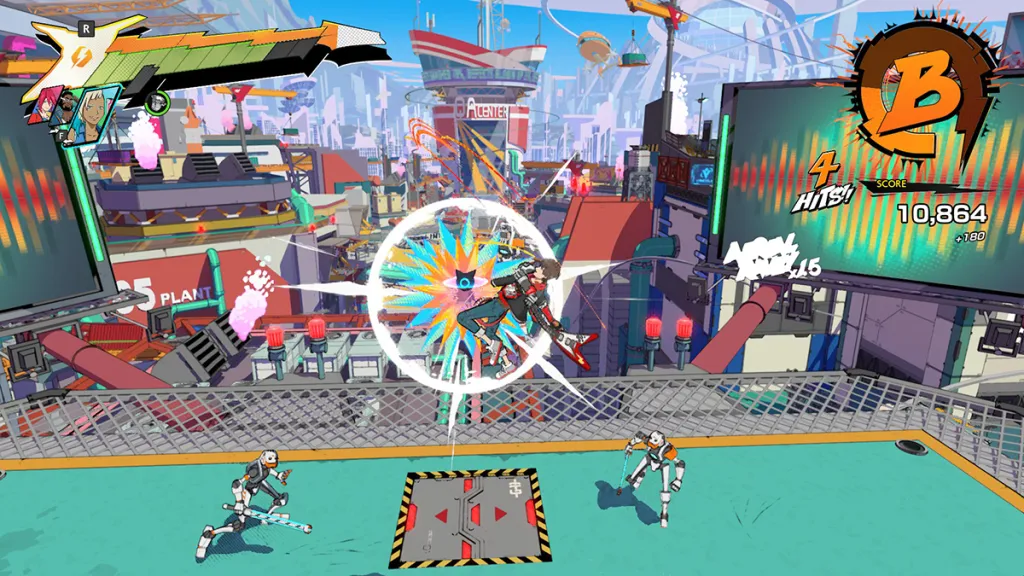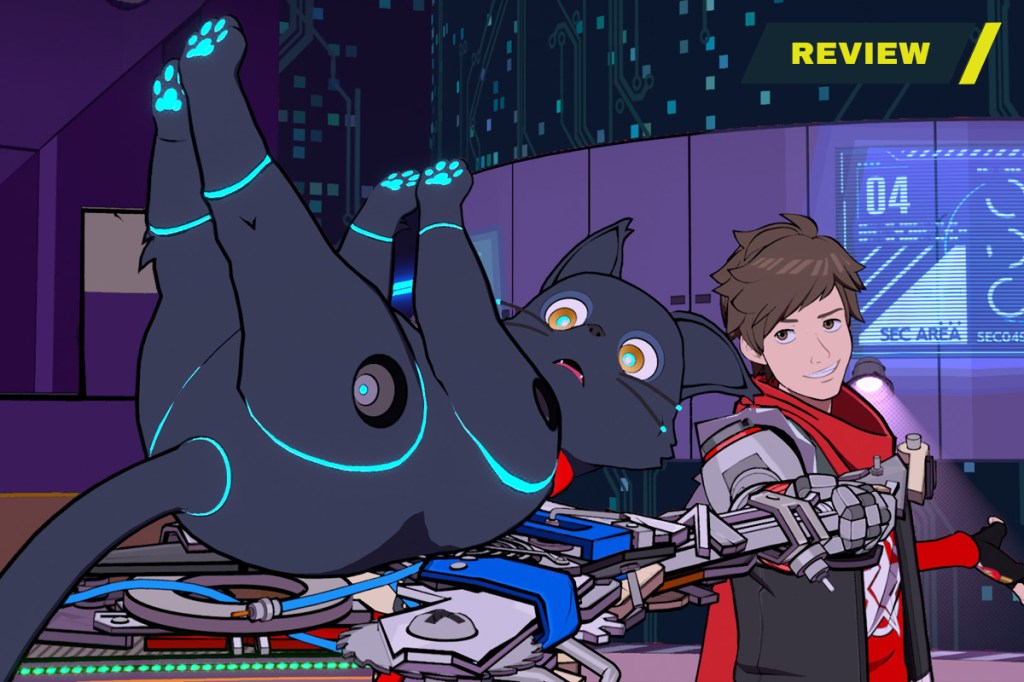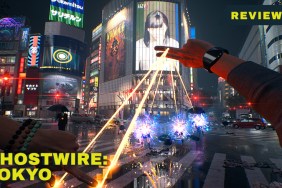It’s always special when a studio breaks away from expectations and creates something that contrasts with its established gameography. Horizon and A Plague Tale are solid franchises, but they are slightly more remarkable knowing those teams previously made gritty first-person shooters and licensed kids games, respectively. Hi-Fi Rush is another entry in that elusive club, as it’s a colorful character action game that comes from a developer that has exclusively only released spooky titles like The Evil Within and Ghostwire: Tokyo. Hi-Fi Rush is not only fresh within the context of Tango Gameworks’ prior work, but also character action games as a whole since this charismatic opener is one of the best debuts the genre has ever had.
It’s an opener that’s bursting with style with stunning art direction, animation, and syncopated cutscenes that all come together in its intro to form a condensed sample of why it’s so unique. Hi-Fi Rush’s cel-shading is, frankly, among the best in the medium since it looks like a cartoon in a way that few games do, evoking (and sometimes besting) Arc System Works’ incredible efforts in the fighting genre.
Not only is it awash with all sorts of bright colors, but it also moves in a way unlike almost any other game at a frequency that makes it all the more notable. Aside from brief dialogue exchanges at the hub, every scene is animated with the utmost detail, providing extravagantly emotive characters that provide such a palpable energy to the whole game. Each cast member strikes comic book-like poses and runs through a gamut of cartoonish expressions at a pace that makes it seem like pure magic since animation of this quality done at this frequency must be sorcery. The way in which it seamlessly moves from gameplay to 3D animation to 2D animation and back to gameplay makes it all the more dazzling. The unique approach and strength of its animation is reminiscent of Spider-Man: Into the Spider-Verse and, with any luck, it will be equally as influential.

Its energetic scenes are only bolstered by how the characters and environment move to the music. Only big actions are timed to the music, while background items bob to the rhythm, meaning it avoids Mickey Mousing since it’s only used just enough to still be effective. The music has more of an impact on gameplay since players are encouraged to dodge, jump, and attack on the beat. All of this is made easier through various elements in the heads-up display that provide all sorts of useful feedback. The most charming example of this is how Chai, the protagonist, snaps his fingers and steps to the beat, which extraordinarily syncs up no matter if he is walking or running.
Its musical wrapping is wonderfully integrated since it is not always mandated, but rewards those who learn its intricacies. Chai can still evade or attack off the rhythm, but he gains certain bonuses for correctly timed actions like extra damage or the ability to chain multiple dashes. This soft encouragement pushes players to get better without harshly punishing those who are still improving. And at its core, it’s a system that incentivizes users to play it quickly, efficiently, and thoughtfully, rewarding those who put in the time with flashy combos that are like violent musical performances.

Chai has learned a lot of his combos from Devil May Cry’s Dante since Hi-Fi Rush borrows liberally from Capcom’s classic (yet inconsistent) franchise. Combat is all about performing juggles and bouncing from foe to foe as quickly and stylishly as possible. It’s a simple premise others have unsuccessfully tried to emulate, but Hi-Fi Rush lives up to those high standards because of its responsive controls and the way in which it balances depth and accessibility. Thanks to a robust amount of animation canceling, Chai attacks and evades with the fluidity the best character action games have and that nimbleness is the rock-solid bedrock of its entire combat system.
This foundation means that it is simply engaging to smack robots with a metallic club, and it doesn’t have an exhaustive Bayonetta-esque list of hard-to-remember button combinations. All of its attacks have different functions and diving into those distinctions is where it derives its depth. Some strike a wide area, while others send a singular target flying and using this in combination with its nifty grappling hook, assists, enhanced partner attacks, and special moves means there are always many ways to keep aerial juggles going for those dexterous enough.
Parrying also yields more defensive options, especially if players go for directional parries, which are harder to pull off but dish out better benefits. Enemies always attack to the beat, making this a satisfying skill to master since it gets players to improvise during their musical beatdowns while still sticking to the rhythm. Parries also play a pivotal role in taking out tougher foes since nailing the timing during these brief mini-games can take out weakened mini-bosses in one satisfying swoop.

Boss fights are the culmination of many of the combat’s best qualities since these musical showdowns synchronize to the track that plays during them. The soundtrack builds as the boss readies up and then continues to escalate as the fight plays out, meaning the tempo rises as the stakes do. These brawls aren’t the hardest tests of skill even on its harder settings, but they’re still cinematic showpieces that are vastly improved by its incredible presentation. And even though it doesn’t have a lock-on button and front-loads most of its upgrades, Hi-Fi Rush’s combat is spectacularly gratifying from its small grunt skirmishes to its big bosses.
Hi-Fi Rush offers plenty of replayability and reasons for players to master its mechanics. Its Bloody Palace-like wave-based survival mode opens up after beating the campaign and strips out the story in favor of something more focused. It’s a true test of skill that even lets users buy items and save their progress, offering a level of flexibility Devil May Cry never did. Hidden doors also open up after rolling credits and hint at a secret ending for those who track them all down and conquer the challenges they hold inside. There’s even a creative Rhythm Master difficulty that, in addition to being much harder, automatically kills the player if they can’t keep a beat. These extra offerings all feed into its upgrade economy and cosmetic unlockables, but they, more importantly, give players more ways to push themselves and experience the game’s fast and fulfilling gameplay.

Hi-Fi Rush‘s narrative is also fulfilling but in a different way. Many of its qualities stem from its aforementioned sensational animation that gives everything more life. Its cutscenes are pleasing to watch because of this smooth and exaggerated movement, and this is often used to sell its jokes. Some of these bits rely and succeed almost solely on the quality of the animation and timing, which is impressive since games are rarely humorous in this way. The writing is also rather funny and never forces quips or annoying references down the player’s throat or tries too hard. Even the mouthy Chai comes off as likable because he’s a positive and endearing idiot, rather than a dork who thinks he’s too cool.
Hi-Fi Rush is a wildly surprising experience for many reasons and unexpectedly suggests that Tango Gameworks, despite its pedigree, is better at making character action games than horror games. Hi-Fi Rush’s combat is nuanced, responsive, and utilizes its musical conceit well to give it its own unique identity. The animation is also a massive achievement that steals the show by providing a wholly original visual style that moves even better than it looks. It excels in just about every area, whereas The Evil Within and Ghostwire: Tokyo came with their share of caveats. It’s a radical shift in tone, but this new tone is a smash hit.
SCORE: 9.5/10
As ComingSoon’s review policy explains, a score of 9.5 equates to “Excellent.” Entertainment that reaches this level is at the top of its type. The gold standard that every creator aims to reach.
Disclosure: The publisher provided a PC copy for our Hi-Fi Rush review. Reviewed on version 4.27.2.0.











